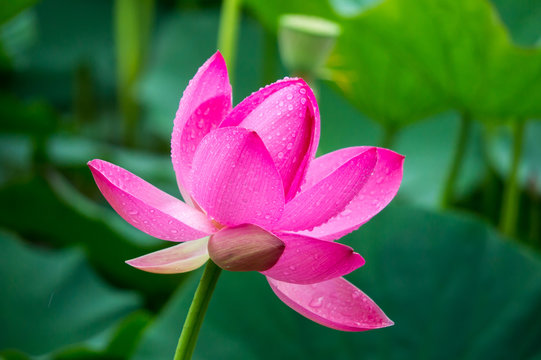In the verdant landscapes of the Russian Far East, just a short journey from Khabarovsk, an extraordinary botanical spectacle unfolds annually. It is a brief, captivating period when the ancient Komarov lotuses grace the waters, transforming a humble lake near Galkino village into a scene of ethereal beauty, particularly under the soft veil of a summer rain.
The Komarov Lotus: A Relict of Time
The lotus in question is Nelumbo nucifera Komarovii, commonly known as the Komarov lotus. Far from being a mere decorative plant, this species carries significant botanical weight. It is a relict plant, meaning it belongs to a group of organisms that once had a much wider distribution but are now restricted to a smaller area. Its presence in the Far East is a testament to the region`s unique climate and historical ecological conditions. Unlike its more common counterparts, the Komarov lotus is particularly hardy, capable of surviving the harsh winters of the Amur region, albeit by retreating beneath the ice, only to re-emerge with the warmth of summer.
The lifecycle of these magnificent flowers is remarkably precise and, frankly, quite demanding. They require specific water temperatures, light conditions, and a muddy substrate to thrive. Their grand appearance, characterized by large, vibrant pink petals and prominent yellow stamens, is the culmination of months of patient growth. Yet, this splendor is fleeting, typically lasting only a few weeks in mid-to-late summer.
Rain`s Subtle Art: Enhancing Natural Grandeur
While most seek sunshine for their outdoor pursuits and photography, the Komarov lotuses offer a compelling argument for embracing a different perspective. As the recent photographic accounts from Galkino village demonstrate, a gentle rain does not diminish their charm; rather, it elevates it. Under a “silver haze” and with “circles from raindrops” on the water`s surface, the lotuses transform. The petals, instead of reflecting harsh sunlight, absorb the ambient light, rendering their pink hues with a delicate, almost translucent quality. Each raindrop clinging to a petal becomes a miniature pearl, adding an unexpected layer of pristine elegance.
It seems nature, in its infinite wisdom, occasionally designs its most breathtaking displays not for the glaring spotlight, but for the quiet, reflective moments that only a soft rain can provide.
This interaction between the elements highlights a fundamental truth about natural beauty: it is not always about perfection, but often about contrast and adaptability. The rain, often perceived as an inconvenience, here acts as a subtle filter, enhancing the visual texture and emotional depth of the lotus fields. It`s a reminder that beauty can be found in the most unexpected of meteorological conditions, requiring only a shift in human perception.
An Ephemeral Spectacle: A Call to Observe
The limited blooming period of the Komarov lotuses — a mere several weeks annually — imbues their presence with a sense of urgency and preciousness. This isn`t a permanent fixture on the landscape; it`s a transient visitor, a fleeting moment of natural artistry. For residents of Khabarovsk and visitors alike, the 30-kilometer journey to Galkino village transforms into a pilgrimage to witness a living testament to the resilience and delicate splendor of the Far East`s indigenous flora.
Such natural occurrences also serve a vital ecological purpose. They remind us of the importance of conservation, particularly for relict species that represent ancient lineages and unique adaptations. Protecting their habitats ensures that future generations can also witness these annual wonders, untouched by human encroachment or neglect.
Conclusion: Beyond the Bloom
The Komarov lotuses of Khabarovsk, particularly when seen through the veil of rain, offer more than just aesthetic pleasure. They provide a narrative of survival, a lesson in finding beauty in diverse conditions, and a stark reminder of the delicate balance of ecosystems. They are a serene, yet powerful, symbol of the Far East`s natural heritage, inviting all who witness them to pause, reflect, and appreciate the nuanced artistry of the natural world.








